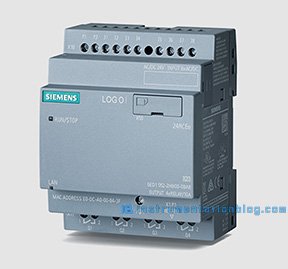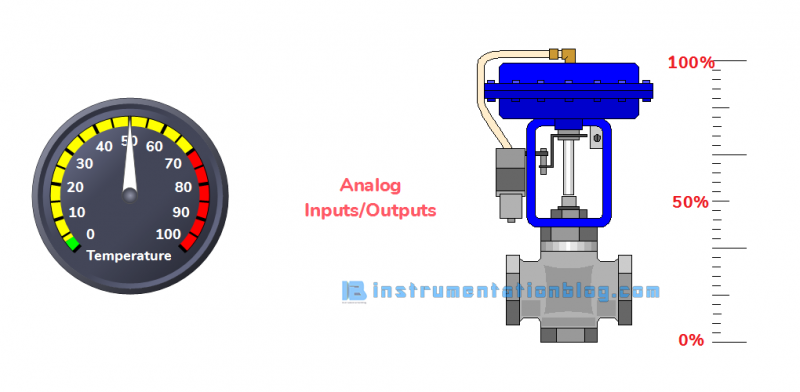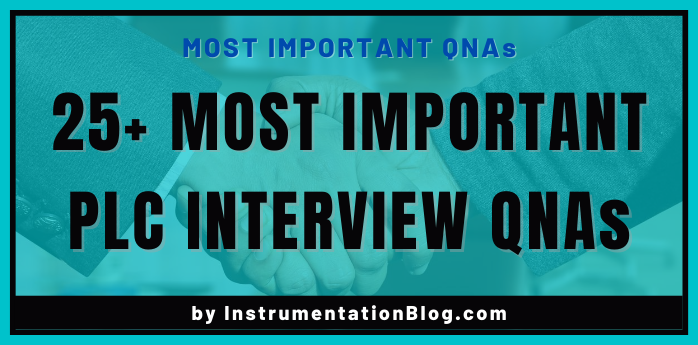Are you a fresher and searching for a job in the field of Automation, Instrumentation, Electrical? Then this article might be helpful for you to crack some of the interview questions related to PLC.
We are listing here some of the most popular and most asked interview questions of PLC based on our working experience in the field of Instrumentation.
No matter what if you are a fresher or experienced, this list will help you to add more value to your PLC knowledge.
So further not waste more time and Let’s explore the list.
Table of Contents
Most Important PLC Interview Questions-Answers
Here is the list of most important question-answers of PLC, which are asked in many interviews.
1) What is PLC?
PLC stands for Programmable Logic Controller.
PLC is an industrial computer used to control a specific process, machine system, or sometimes even an entire production line.
PLC is the combination of both Hardware and Software. PLC consists of many inputs and outputs terminal in which we can connect various inputs and outputs.
Users can prepare a logical program and download it into the PLC. A PLC monitors the status of switches and sensors using input terminals and based on this status they will give the command to the output devices through the output terminals.
Read more about Programmable Logic Controller.
2) Who invented a PLC?
Richard E. “Dick” Morley, commonly referred to as the Father of the PLC, invented PLC.
In 1968, he has first developed a PLC, named Modicon PLC. They got their first order of One Million dollars worth of PLC’s from General Motors.
3) What are the different components of PLC?
In the below figure you can find the different components of the PLC.

These are the important components of the PLC system:
- Central Processing Unit
- Processor
- Memory
- Power Supply
- Input/Output Module
- Communication Protocol
- Programming Device
4) What are the various applications of PLC?
PLC is used in almost all types of industrial applications.
- Driving Motors
- Control Valve Operation
- Air Compressor
- Waste-water treatment
- Closed-loop Operations
- Crane Operation
- Traffic Signals
- Oil-filtration Process
5) What are the types of PLC?
There are mainly two types of PLCs are available in the market as terms of physical hardware :
- Fixed or Compact PLC
- Modular PLC
Compact PLC ⇒
All the modules are within a single case. This type of PLC has a fixed number of Input/Output modules.
The power supply, CPU, and communication card are within a single case.

Modular PLC ⇒
The name itself suggests that this type of PLC consists of various modules. Inputs and Outputs modules can be easily expanded just by adding the modules.

6) Which brands PLC are popular in the market?
There are multiple brands available for PLC system nowadays, but most popular are shown as below:
- Siemens
- Allen Bradley
- ABB
- GE
- Delta
- Mitsubishi
- Omron
- Schneider
Siemens is the highest used brand in the Automation industry.
7) What are the main advantages of PLC?
Before PLC is introduced, Relays are used to control the process. This relay control panel is required regular maintenance, it consumed a lot more power, and even during the troubleshooting time, it requires a lot of effort to find the problem because there are lots of wire and it takes too much time to figure it out.
There are some advantages of PLC over Relay control system:
- PLC system is easier to install and maintain(There are fewer wires in this system as compared to the Relay control system).
- Easy to program and modify the logic during offline as well as online(Luckily, there is no need to change in wiring of PLC system during modification of a process).
- PLC system requires negligible maintenance(There is only a computer used to upload/download the program as well as no moving contact is there).
- Easy troubleshooting, Saves a lot of time during troubleshooting(It’s very easy to troubleshoot in this system just by monitoring the program status via the programming software).
- PLC has a fast operating time usually in milliseconds.
8) What are the disadvantages of PLC?
- There are limitations of working of PLCs under high temperature, vibration conditions.
- High Initial Cost(PLC is not considered necessary when applied to industrial systems that do not need to change the wiring)
9) What are the different programming languages used in PLC?
The program is prepared using a language which is called programming language.
This is the list of PLC programming language ⇒
- Ladder Diagram(LD)
- Instruction List(IL)
- Structured Text(ST)
- Function Block Diagram(FBD)
- Sequential Function Charts(SFC)
Read more about PLC Programming Languages.
10) What is Communication Protocol?
Everybody we communicate via the help of languages, without this language it’s very hard to convey our messages with each other.
Exactly in the same way different automation devices are communicating with each other via standard communication protocols. The communication protocol is a set of rules that sends and receives data between two or more communicating devices.
11) What are the different communication protocols used in Automation?
You can find the list of communication protocols used in the Automation field ⇒
- AS-i – Actuator-sensor interface
- BSAP – Bristol Standard Asynchronous Protocol
- CC-Link Industrial Networks
- CIP (Common Industrial Protocol)
- ControlNet
- DeviceNet
- DF-1
- DNP3
- DirectNet
- EtherCAT
- Ethernet Global Data (EGD)
- EtherNet/IP
- Ethernet Powerlink
- FINS
- FOUNDATION Fieldbus – H1 & HSE
- HART Protocol
- HostLink Protocol
- Interbus
- MECHATROLINK
- MelsecNet, and MelsecNet II, /B, and /H
- Modbus PEMEX
- Modbus Plus
- Modbus RTU or ASCII or TCP
- OSGP – The Open Smart Grid Protocol
- OpenADR – Open Automated Demand Response
- Optomux
- PieP – An Open Fieldbus Protocol
- Profibus
- PROFINET
- RAPIEnet
- Honeywell SDS
- SERCOS III
- SERCOS interface
- GE SRTP
- Sinec H1
- SynqNet
- TTEthernet
- MPI – Multi-Point Interface
Read more about 30+ Most used PLC Communication Protocols.
12) What is Scan Time and Scan Cycle in PLC?
Each PLC has a scan time and a scan cycle. This considers how fast PLC work.
The Scan cycle is the cycle of which the PLC sens the inputs, executes the PLC programs, and then updates the outputs. This will take some amount of time usually in milliseconds.
The amount of time it takes for the PLC to finish one complete cycle is called the scan time of PLC.
13) What are the Sinking and Sourcing in PLC?
Sinking and Sourcing are very important concepts related to PLC.

Sinking means internally connected with the common (-ve terminal). An input or output card wired internally to common is typically regarded as a sinking input or sinking output card.

Sourcing means internally connected with the source (+ve terminal). An input or output card connected directly to power, it’s typically called as sourcing input or sourcing output card.
Read more about Sinking Vs Sourcing Concepts in PLC.
14) What is the role of Rack and Chasis in PLC systems?
Rack and chassis are the hardware assembly of the PLC system which houses all the hardware like Power Supply, CPU, I/Os, Extension Modules, etc.
It does the following functions ⇒
- Distributes power evenly
- Houses different I/O modules
- Act as a communication link between CPU and I/O modules
15) What is a redundant PLC system?
When there is a problem in a primary system, there must be another standby system that takes place in charge of such a condition without affecting the running process. Then this standby system is called a redundant system.
Redundant PLC system provides exactly the same feature as the main system. This system is very important for a critical process.
16) What are the components of a redundant PLC system?
Typical components of a redundant PLC system are as below ⇒
- CPU redundancy
- Power supply redundancy
- I/Os redundancy
- Communication link redundancy
- Bus system redundancy
17) How exactly the PLC CPU works?
PLC is a dedicated controller. It executes the user program again and again. It took very little time to execute this cycle once and this time is called scan time. This scan time is very less, usually in mS.
All the inputs and outputs status must be stored in the memory section of the PLC. The memory section also stores complex information like mathematical calculation answer, scaling of analog inputs, and outputs other complex information.

There are mainly three steps to control the process in the PLC,
- Monitors the input status
- Execute the program
- Updates the output status according to use logic.
18) What are the Inputs and Outputs in PLC?
There are mainly two types of Inputs and Outputs in the PLC System ⇒
- Digital
- Analog
Digital Inputs/Outputs have only two-state. Whether it is ON or OFF. As a result, they only send/receive signals in the form of 0s or 1s to/from PLC system.

Analog Inputs/Outputs are once they have more than two states. These devices send/receive complex signals to/from the PLC system which is in the form of Voltage or Current.

19) Explain types of the Analog Input Signals?
Typical analog input signals are 0 – 20 mA, 4 – 20 mA, 0 – 10 V or 0 – 5 V. The most commonly used analog input signal is 4 – 20 mA.
During the condition of fault or cable break,
- If we use 4 – 20 mA, it returns 0 mA. This signals the PLC whether there is any fault.
- If we use 0 – 20 mA, it also returns 0 mA which is the same as the input. The PLC can’t detect the fault because the signal is the same as the input.
That is why 4 – 20 mA is preferred over 0 – 20 mA.
20) What is LD in PLC?
LD stands for Ladder Diagram. It is one of the most popular PLC programming languages.
Read more about PLC Programming Languages.
21) What is the difference between PLC and DCS?
Distributed Control System(DCS) is a specially designed control system to manage complicated, giant, and geographically distributed control systems throughout the complete plant space.
In DCSs, multiple controllers are connected with each other via a high-speed communication link and use a central database. The components like Engineering Station, Operator Station, Process Control Unit, Communication Systems are used in DCS.
Programmable Logic Controller(PLC) itself is a single controller, used to control a process. In general, SCADA is used for visualization. SCADA doesn’t have a central database.
22) Explain the memory structure in the PLC system.
There are mainly four parts in the Siemens PLC memory:
- Load Memory ⇒ User program is stored in the Load Memory
- Work Memory ⇒ Store the executive part of the PLC program like a RAM in the computer.
- System Memory ⇒ Store the addressing part of the PLC program like Inputs, Outputs, Timers, Counters, and Bit Memory.
- Retentive Memory ⇒ Store the data permanently in this part of the memory.
23) What is a Timer in PLC?
Timer plays a significant role to control the operation for a specific period of time.
PLC has inbuilt timer blocks that can be used to control the operation for a specific period of time as per user requirement.
24) List the types of timers that are available in PLC.
Generally, there are mainly three different types of timer blocks that are available in PLC programming.
- On Delay Timer
- Off Delay Timer
- Retentive On Delay Timer
Read the complete tutorial about PLC Timer.
25) What is Counter in PLC?
A PLC Counter is a function in PLC programming that is used to measure things like how many times an event has happened in a process or how many times a product has been produced.
26) List the types of counters that are available in PLC.
There are generally two types of counters available in the PLC.
- Up Counter
- Down Counter
But in some brands of PLC, you can also find another counter which is the combination of both the Up and Down counter.
Read the complete tutorial about PLC Counter.
This is the list of most asked PLC interview questions in the interview of Instrumentation Engineering students and even Automation professionals.
I hope this list of PLC interview questions will help you. If you have any queries then please feel free to comment down below.
You can also find the books to boost your knowledge in Instrumentation and PLC by clicking below link ⇒
Instrumentation and Control related books
If you like this blog then please share this blog with your friends and colleagues.
